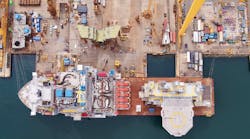Statoil completes 2017 UK drilling with Outer Moray Firth discovery
Tayvis Dunnahoe
Exploration Editor
Statoil ASA has discovered 25-130 million bbl of oil in Verbier sidetrack Well 20/05b-13Z in the outer Moray Firth on the UK Continental Shelf (UKCS).
Jez Averty, senior vice-president, exploration, in Norway and the UK, said the oil was proven in "good quality sands with good reservoir properties, but significant work remains…to clarify recoverable volumes and refine this range."
The Verbier main wellbore (20/05b-13) was drilled to a planned depth of 4,267 m, encountering a water-bearing Upper Jurassic sand and the sidetrack was drilled to assess the remaining potential up-dip, Statoil said.
Fig. 1 Statoil's Mariner A topsides sails away from Daewoo Shipbuilding & Marine Engineering on Dockwise Ltd.'s Forte heavy transport vessel in May 2017. Photo from Eva Sleire, Statoil.
Statoil operates Verbier with 70% ownership, which it purchased from Jersey Oil & Gas PLC and CEICO Exploration & Production (UK) Ltd. in 2016 (OGJ Online, Aug. 23, 2016). Jersey and CEICO maintain 18% and 12% interest in Verbier, respectively.
The P.2170 license in which the well lies includes Blocks 20/5b and 21/1d in the Buchan graben the Outer Moray Firth offshore northeast Scotland.
Drilling campaign
The Verbier discovery was the last of three exploration wells Statoil drilled beginning in July (OGJ Online, July 5, 2017). The Transocean Spitsbergen semisubmersible rig also completed Mariner Segment 9 and Jock Scott.
Jenny Morris, Statoil's vice-president, exploration, in the UK, described results from the other two wells as "disappointing," but said that Verbier's results justified continued exploration efforts on the UKCS.
Mariner Segment 9 encountered two oil-filled sands in the Heimdal formation and a thin oil column in the deeper Maureen formation. The company acquired data to establish the extent of the Heimdal sand bodies and is considering potential tieback to the main Mariner heavy oil field. In July, Statoil had hoped the Mariner Segment 9 well would prove additional resources and increase the extent of Mariner field (OGJ Online, Dec. 2, 2016). The results are not a setback, however, as Mariner remains on track to begin production in late 2018.
The Transocean Spitsbergen completed three wells on the UK Continental Shelf beginning in July. Photo from Transocean Ltd.
Mariner was discovered in 1981 on the East Shetland Platform about 150 km east of the Shetland Islands. The heavy-oil development consists of two shallow sections including the Maureen formation at 1,492 m and the Heimdal reservoir at 1,227 m. Mariner field is expected to produce 250 million bbl of oil during its 30-year lifespan, averaging a plateau production of 55,000 b/d.
Statoil's Jock Scott well tested the underexplored margins of the Viking Graben without success, but the operator continues to weigh future options. Erik Haaland, spokesperson for Statoil, told OGJ, "There are no further wells planned in the UK for 2017, and we have not yet concluded exploration plans for 2018."
In April, Transocean Ltd. reported that Statoil had awarded Spitsbergen two contracts worth $83 million, including the now-completed UKCS three-well contract and a six-well, 1-year contract in the Norwegian North Sea.
Outer Moray Firth
The Verbier discovery is good news for offshore exploration on the UKCS. Mhairidh Evans, senior research analyst, WoodMackenzie, said, "UK exploration has had a bit of revival in the last couple years with more activity and success."
The Moray Firth region has been without major discoveries since 2007, when Nexen Petroleum UK Ltd. made its Golden Eagle discovery. The field began production in November 2014 and contains an estimated 140 million bbl of oil in Upper Jurassic and Lower Cretaceous reservoirs (OGJ Online, Nov. 3, 2014).
Moray Firth is in about 120 m of water and mature. Athena and Ettrick-Blackbird fields have ceased production in the past few years, but Verbier's development may add new infrastructure allowing for redevelopment in some older fields.
"Statoil will likely perform more appraisal in the Moray Firth area, and we expect Verbier will spur new exploration in the region," Evans said.
Verbier's 25-130 million bbl reserves range is wide, but even "if it fell in the mid-case it would be the biggest discovery in the Moray Firth region since 2007," Evans said.
Further appraisal
P.2170 Blocks 20/5b and 21/1d were awarded to Jersey Oil & Gas as a traditional license in the UK 28th licensing round. Statoil paid $2 million cash for 70% of the license in 2016 and, as part of the farm-out agreement, financed $25 million of the first exploration well drilled.
At the time of purchase, Statoil cited nearby oil finds Buzzard and Buchan as possible targets.
The partners are continuing to assess the data to consider next steps in the P.2170 license. According to Jersey Oil & Gas, the Verbier discovery will enhance knowledge on the license's other prospects, Cortina and the Maribel lead.

